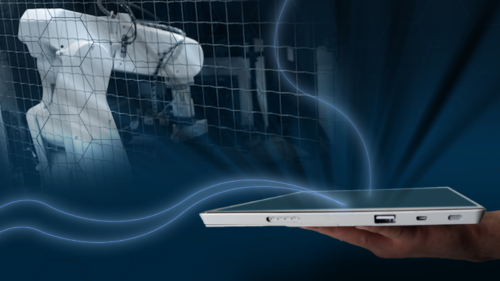Photoelectric Sensors – 2005-08-15
Photoelectric sensors are typically available in at least nine or more sensing modes, use two light sources, are encapsulated in three categories of package sizes, offer five or more sensing ranges, and can be purchased in various combinations of mounting styles, outputs, and operating voltages. It creates a bewildering array of sensor possibilities and a catalog full of options.
|
Photoelectric sensors are typically available in at least nine or more sensing modes, use two light sources, are encapsulated in three categories of package sizes, offer five or more sensing ranges, and can be purchased in various combinations of mounting styles, outputs, and operating voltages. It creates a bewildering array of sensor possibilities and a catalog full of options.
This plethora of choices can be narrowed in two ways: The first has to do with the object being sensed. Second involves the sensor’s environment.
Boxed in
The first question to ask is: What is the sensor supposed to detect? “Are we doing bottles? Or are we detecting cardboard boxes?” says Greg Knutson, a senior applications engineer with sensor manufacturer Banner Engineering.
Optical properties and physical distances will determine which sensing mode and what light source work best. In the case of uniformly colored boxes, for example, it might be possible to use an inexpensive diffuse sensor, which reflects light from the box.
The same solution, however, can’t be used when the boxes are multicolored and thus differ in reflectivity. In that case, the best solution might be an opposed or retroreflective mode sensor. Here, the system works by blocking a beam. When a box is in position, the beam is interrupted and the box detected. Without transparent boxes, the technique should yield reliable results. Several sensors could gauge boxes of different heights.
Distance plays a role in selecting the light source, which can either be an LED or a laser. LEDs are less expensive. However, because LEDs are a more diffuse light source, they are better suited for shorter distances. A laser can be focused on a spot, yielding a beam that can reach long distances. Tight focus can also be important when small features have to be sensed. If a small feature has to be spotted from several feet, it may be necessary to use a laser.
Laser sensors used to cost many times more than LEDs. That differential has dropped with the plummeting price of laser diodes. There’s still a premium for using a laser, but it’s not as large as in the past.
Environmental challenges
Operating environment is the other primary determining factor in choosing a sensor. Some industries, such food and automotive, tend to be messy, dangerous, or both. In the case of food processing, humidity can be high and a lot of fluids can be present. Automotive manufacturing sites that process engines and other components may include grit, lubricants, and coolants. In such situations, the sensor’s environmental rating is of concern. If the sensor can’t handle dirt, then it can’t be used. Such considerations also impact the sensing range needed because it may be necessary to station the sensor out of harm’s way and at a greater distance than would otherwise be desirable. Active alarming and notification may be useful if lens gets dirty and signal degrades.
Similar environmental issues apply to the sensor’s size, which can range from smaller than a finger to something larger than an open hand. A smaller sensor can be more expensive than a larger one because it costs more to pack everything into a small space. Smaller sensors also have a smaller area to collect light and therefore tend to have less range and reduced optical performance. Those drawbacks have to be balanced against a smaller size being a better fit for the amount of physical space available.
Sensors used in semiconductor cleanroom equipment, for example, don’t face harsh environmental conditions, but do have to operate in tight spaces. Sensing distances typically run a few inches, thus the sensors tend to be small. They also often make use of fiber optics to bring light into and out of the area where changes are being detected.
Mounting, pricing
Another factor to consider is the mounting system. Frequently, sensors must be mechanically protected with shrouds and other means. Such mechanical and optical protection can cost more than the sensor itself—a consideration for the buying process. If vendors have flexible mounting systems and a protective mounting arrangement for sensors, the products could be easier to implement and last longer.
List prices for standard photoelectric sensors range from $50 or so to about $100.
Laser and specialty photoelectric sensors cost between $150 and $500. Features such as a low-grade housing, standard optical performance, and limited or no external adjustments characterize the lower ends of each category. The higher end will have a high-grade housing, such as stainless steel or aluminum, high optical performance, and be adjustable in terms of gain or allow timing and other options. Low-end products are suitable for general applications, while those at the higher end may offer application-specific operation at high speed, high temperature, or in explosive environments.
Finally, keep in mind that one sensing technology may not meet all of the needs of an application. And if needs change, a completely different sensor technology may be required. Having to switch to a new approach can be made simpler if a vendor offers multiple technologies in the same housing and mounting footprint, notes Ed Myers, product manager at sensor manufacturer Pepperl+Fuchs. If that’s the case, then one technology can be more easily swapped out for another as needs change.
Sensor checklist
Size
Sensing mode
Sensing range
Mounting style
Output
Operating mode
Operating voltage
Light source
Connection style
Housing material
Special considerations include:
Ability to handle high speed and/or high temperatures,
Logic control,
PC programming, and
Network compatibility.
Do you have experience and expertise with the topics mentioned in this content? You should consider contributing to our CFE Media editorial team and getting the recognition you and your company deserve. Click here to start this process.





